

Do aid agencies skew the debate? Framing news in Africa – how journalists approach stories and reinforce stereotypes – By Keith Somerville. Mokhtar Belmokhtar, organiser of the In Amenas hostage-taking, is a useful framing device for journalists in the growth of the War on Terror narrative in Mali.

Having worked as a journalist for 33 years and having taught journalism and analysed the processes and performance of journalism for the last five, it is very revealing watching and analysing the development of major stories. There have been two dominant ones in the news about Africa over the past couple of weeks – the Mali conflict and the Pistorius-Steenkamp murder hearings. Each in their way tell us things about the way journalists work, in general, and in relation to Africa, in particular. One of the basic ways of looking at how news is reported, about how journalists select and represent events, personalities, countries, regions and continents, is through the idea of ‘framing’.
How do we communicate global poverty? Creatively Communicating Complex Ideas. Dochas.
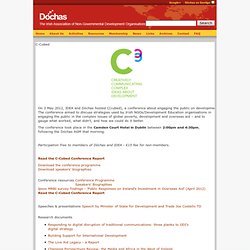
Resetting the Aid Relationship. The aid and deve lopment sector has been a pioneer within the engagement field, developing practical and innovative methodologies such as Participatory Appraisal as well as embedding concepts such as ownership through participation as part of mainstream policy.
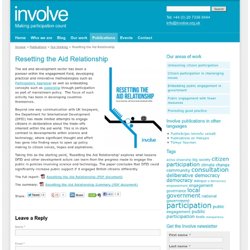
The focus of such activity has been in developing countries themselves. Beyond one way communication with UK taxpayers, the Department for International Development (DFID) has made limited attempts to engage citizens in deliberation about the trade-offs inherent within the aid world. This is in stark contrast to developments within science and technology, where significant thought and effort has gone into finding ways to open up policy making to citizen voices, hopes and aspirations. Finding Frames: New ways to engage. Frames & Values: promoting public engagement. Framing Development. Using cartoons to Communicate Development « Dochasnetwork's Blog. 10/04/2012 at 4:55 pm On 3 May, Dóchas and IDEA are hosting a conference on Communicating Development: See here.
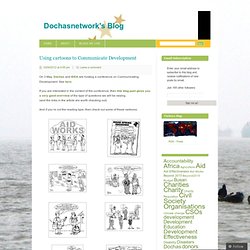
If you are interested in the content of the conference, then this blog post gives you a very good overview of the type of questions we will be raising. (and the links in the article are worth checking out) And if you’re not the reading type, then check out some of these cartoons: NB: If you decide to use any of these, please credit Richard Duszczak of Cartoon Studio Ltd PS: we know: these cartoons don’t communicate “Development” – they merely provide a witty and unfair commentary on Northern NGO communications practice.
Post script: C-Cubed Conference Report. History and the development aid debate in the Republic of Ireland - Policy & Practice - A Development Education Review. Introduction In September 2006, more than thirty-two years after its publication was first discussed, the Irish government issued its White Paper on Irish Aid. Designed to encourage a greater public understanding of the official aid programme, the document contained more than a passing reference to the role of the past in shaping Irish Aid’s present. Speech by Minister Costello. NGOs Try Out Humor. Does it Work? When done well, humor can prove to be an excellent tool in shedding light on a serious issue.
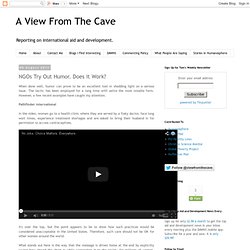
The tactic has been employed for a long time with satire the most notable form. However, a few recent examples have caught my attention. Pathfinder International In the video, women go to a health clinic where they are served by a flaky doctor, face long wait times, experience treatment shortages and are asked to bring their husband in for permission to access contraceptives. Want me to listen? Tell me a story. If you’ve ever had any doubts that international aid or global health is a business, then one visit to an International AIDS Conference will clear them away.
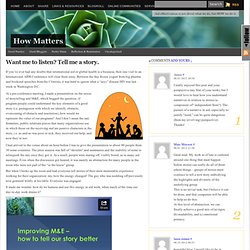
Between the free frozen yogurt from big pharma and bookend speeches from the Clintons, it was hard to ignore what a “sexy” disease HIV was last week in Washington D.C. At a pre-conference meeting, I made a presentation on the nexus of storytelling and M&E, which begged the question–if program people could understand the key elements of a good story (i.e. protagonist with which we identify, obstacle, overcoming of obstacle and resolution), how would we represent the value of our programs? Data Visualisations. ChangeNation. What’s the Message? – Communicating development better together. What’s the Message?
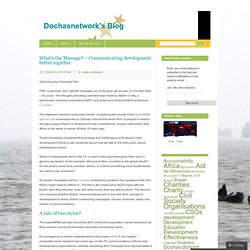
– Communicating development better together 12/06/2012 at 10:53 am Guest blog by Franziska Fehr. Irish NGOs and Social Networking: “Think Relationships, not Campaigns” 06/01/2012 at 11:24 pm.
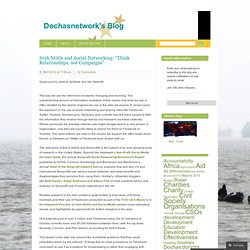
Humanitarian Appeals: Messages and Connotations. 30/01/2012 at 2:40 pm Guest post by Emer McCarthy and Grace Duffy* Our perceptions of the Developing World shape our interactions with it.
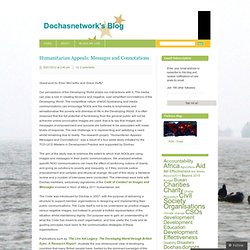
Of Haitian Puppet Shows: Communicating Better. A lot of work has been done in recent years to ‘professionalise’ humanitarian aid and development work.

Reputable organisations don’t see themselves as ‘charities’, paternalistically handing things out to their many grateful dependents. They’re not staffed entirely by well-meaning volunteers with no immediately-observable skills. Mind the gap: knowing and acting. Engaging Minds: Language analysis. Winning the Story Wars - The Hero's Journey (2012) Winning the Story Wars - The Myth Gap. Becoming a Networked Nonprofit. Redesigning your nonprofit organization to become more participatory, open, authentic, decentralized, collective, and effective—via social media, networks, and beyond. The environment in which nonprofits are doing their social change work has changed dramatically over the past five years. It’s more complex, online networks are central to our lives and work, and stakeholders want more involvement. Seeing tangible results from your organization’s social change efforts now requires two things to be successful: leading with a network mindset, and using measurement and learning to continuously improve.
It is just not about using the tools—having a Facebook brand presence or tweeting as the CEO of your organization—it is a total redesign of your organization. A network mindset exercises leadership through active participation, openness, decentralized decision-making, and collective action. Success happens for nonprofits if they take small, incremental, and strategic steps.